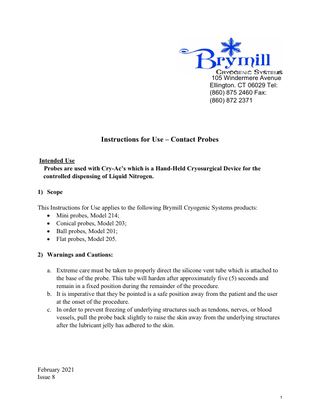Brymill
Cry-Ac's Contact Probes Instructions for Use Issue 8 Feb 2021
Instructions for Use
3 Pages

Preview
Page 1
105 Windermere Avenue Ellington. CT 06029 Tel: (860) 875 2460 Fax: (860) 872 2371
Instructions for Use – Contact Probes Intended Use Probes are used with Cry-Ac’s which is a Hand-Held Cryosurgical Device for the controlled dispensing of Liquid Nitrogen. 1) Scope This Instructions for Use applies to the following Brymill Cryogenic Systems products: • Mini probes, Model 214; • Conical probes, Model 203; • Ball probes, Model 201; • Flat probes, Model 205. 2) Warnings and Cautions: a. Extreme care must be taken to properly direct the silicone vent tube which is attached to the base of the probe. This tube will harden after approximately five (5) seconds and remain in a fixed position during the remainder of the procedure. b. It is imperative that they be pointed is a safe position away from the patient and the user at the onset of the procedure. c. In order to prevent freezing of underlying structures such as tendons, nerves, or blood vessels, pull the probe back slightly to raise the skin away from the underlying structures after the lubricant jelly has adhered to the skin.
February 2021 Issue 8 1
3) Technique a. Select the appropriate contact probe based on the procedure and the size of the target area to be treated. b. Attach the probe to the permanently affixed Knurled Nut on the Cry-Ac®, Cry-Ac-3®, or Cry-Baby® using finger tight firmness. c. Ensure the area to be treated is as dry as possible. d. Apply a small amount of lubricant jelly to cover the lesion. e. Touch the end of the probe to the jelly but not the skin. f. Depress the finger trigger to release the liquid nitrogen. g. As the probe begins to the freeze, the lubricant jelly will harden and attach to the skin (known as cryo-adhesion). h. “Freeze time” commences upon cryo-adhesion of the lubricant jelly. To limit the depth of the freeze, pull the probe back slightly to raise the skin away from the underlying structures. To obtain a deeper depth of freeze, apply a small amount of pressure to the probe after cryo-adhesion has occurred. i. Upon completion of freezing, allow the probe to thaw before trying to separate the probe from the lubricant jelly on the skin. If done prematurely, it may result in a skin tear. A slight gentle twisting motion of the unit may expedite the release of the probe. 4)
Cleaning MANUAL CLEANING PROCEDURE
Perform the manual cleaning procedure as follows: a. Prepare a bath of ambient temperature utility (tap) water. b. Moisten a lint-free cloth in the utility water bath and wipe the device for 1 minute to remove as much debris as possible. Use a fresh lint-free cloth as necessary. NOTE: Take care not to get water inside the lumens. c. Prepare an Enzol bath using lukewarm utility water, (31-40 degrees C), with a recommendation of 1 oz/gallon. d. Immerse each device in detergent solution. NOTE: Take care not to get water inside the lumens. e. After the 1-minute soak time but while immersed, wipe each device thoroughly with a lintfree cloth for at least 1 minute. f. Pay particular attention to hard to clean areas such as rough surfaces and joints. NOTE: Take care not to get water inside the lumens. g. Using a fresh lint-free cloth moistened with (deionized) water, wipe each probe thoroughly to remove residual detergent. h. Pay careful attention to difficult to clean areas such as joints, and rough surfaces. i. Using a lint free cloth and to thoroughly dry the devices, including any lumens and rough surfaces. NOTE: Be certain the devices are thoroughly dried before use. February 2021 Issue 8 2
5.)
Sterilization Use the following recommended validated sterilization parameters: of sterilization. a. Moist heat sterilization with Gravity cycle is the recommended method of sterilization. b. Vaporized Hydrogen (VHP), Ethylene oxide (EO), gas plasma and dry heat are not recommended sterilization methods for reusable instruments. c. The recommended parameters demonstrate the minimum validated steam sterilization time and temperature required to achieve a 1.0 x 10-6 sterility assurance level (SAL). d. Sterilize the instruments after placing them in a Stainless-Steel Sterilization Tray and wrapping the tray is double layer of Bioshield Sterilization Wrap using the envelope technique. e. The validated reprocessing instructions are not applicable to trays that include devices not manufactured or distributed by Brymill. Cycle Time
Temperature
Gravity
121*C (250*F)
Exposure Time 30
Dry Time 15
f. Replace the silicone vent tubing prior to use. If you have any other questions or comments, please do not hesitate to contact us on (800) 7772796 (USA) or +44 (0) 1256 841045 (UK) or email us at brymill@brymill.com. CAUTION: U.S. Federal law restricts this device to sale by or on the order of a physician or veterinarian. ----------------------------------------------------------------------------------------------------------------------
EU Authorized Representative –
Rosa Maria Sallent Moya, Calle Jaume Balmes, 59, 08830 Sant Boi de LLobregat SPAIN Phone: +34 616602892 Email:brymill.internationalsales@gmail.com
1639
February, 2021 Issue 8 3